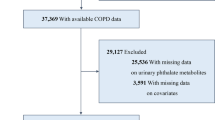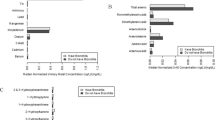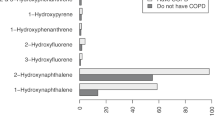Abstract
In vivo and in vitro studies have found that exposure to bisphenol A (BPA) can lead to pulmonary diseases, but there exists little evidence regarding the association between urinary BPA level and chronic obstructive pulmonary disease (COPD)-related diseases in the population. National Health and Nutrition Examination Survey data, from 2005 to 2016, were utilized in this study. Participants who self-reported having emphysema, chronic bronchitis, or COPD were defined as having COPD-related diseases. A multivariate logistic regression analysis was used to analyze the association of urinary BPA with COPD-related diseases in the overall population and according to sex. Three separate models including different covariates were used in our analyses. The association of urinary BPA with COPD-related diseases in different subgroups (age, smoking status, participants belonging to “ever had asthma” and “ever had cardiovascular disease”) other than sex was also analyzed. Based on the different models, 9189, 7006, and 6946 participants were used in our study. BPA was found to be significantly associated with COPD-related diseases in all models. The concentration of BPA in urine was significantly associated with COPD-related diseases regardless of whether BPA concentration was treated as a continuous variable (odds ratio (OR): 1.24, 95% confidence interval (CI): 1.11–1.38, in model 3) or as tertiles (OR: 2.01, 95% CI: 1.49–2.72, between the lowest group and highest group, in model 3). This association was significant among male but not female participants. BPA also demonstrated a significant association with emphysema and chronic bronchitis in adults, particularly in males. No significant interaction was found for all the other subgroup analyses. Urinary BPA was associated with COPD-related diseases in adult participants, especially males.


Similar content being viewed by others
Data availability
The datasets used and analyzed during the current study are available at https://www.cdc.gov/nchs/nhanes/about_nhanes.htm.
References
Adeloye D, Song P, Zhu Y, Campbell H, Sheikh A, Rudan I (2022) Global, regional, and national prevalence of, and risk factors for, chronic obstructive pulmonary disease (COPD) in 2019: a systematic review and modelling analysis. Lancet Respir Med 10:447–458
Bauer SM, Roy A, Emo J, Chapman TJ, Georas SN, Lawrence BP (2012) The effects of maternal exposure to bisphenol A on allergic lung inflammation into adulthood. Toxicol Sci 130:82–93
Bowe B, Xie Y, Yan Y, Al-Aly Z (2019) Burden of cause-specific mortality associated with PM2.5 air pollution in the United States. JAMA Netw Open 2:e1915834
Burney PG, Patel J, Newson R, Minelli C, Naghavi M (2015) Global and regional trends in COPD mortality, 1990–2010. Eur Respir J 45:1239–1247
Cai S, Rao X, Ye J, Ling Y, Mi S, Chen H et al (2020) Relationship between urinary bisphenol a levels and cardiovascular diseases in the U.S. adult population, 2003–2014. Ecotoxicol Environ Saf 192:110300
Choi JY, Lee J, Huh DA, Moon KW (2022) Urinary bisphenol concentrations and its association with metabolic disorders in the US and Korean populations. Environ Pollut (barking, Essex: 1987) 295:118679
National Research Council (1995) Measuring poverty: a new approach. Washington, DC: The National Academies Press. https://doi.org/10.17226/4759
Duffy SP, Criner GJ (2019) Chronic obstructive pulmonary disease: evaluation and management. Med Clin North Am 103:453–461
Erden ES, Motor S, Ustun I, Demirkose M, Yuksel R, Okur R et al (2014) Investigation of bisphenol A as an endocrine disruptor, total thiol, malondialdehyde, and C-reactive protein levels in chronic obstructive pulmonary disease. Eur Rev Med Pharmacol Sci 18:3477–3483
Ferris BG (1978) Epidemiology standardization project (American Thoracic Society). Am Rev Respir Dis 118:1–120
Galloway T, Cipelli R, Guralnik J, Ferrucci L, Bandinelli S, Corsi AM et al (2010) Daily bisphenol A excretion and associations with sex hormone concentrations: results from the InCHIANTI adult population study. Environ Health Perspect 118:1603–1608
Gore AC, Chappell VA, Fenton SE, Flaws JA, Nadal A, Prins GS et al (2015) EDC-2: the Endocrine Society’s second scientific statement on endocrine-disrupting chemicals. Endocr Rev 36:E1–E150
Huo X, Chen D, He Y, Zhu W, Zhou W, Zhang J (2015) Bisphenol-A and female infertility: a possible role of gene-environment interactions. Int J Environ Res Public Health 12:11101–11116
Jurewicz J, Majewska J, Berg A, Owczarek K, Zajdel R, Kaleta D et al (2021) Serum bisphenol A analogues in women diagnosed with the polycystic ovary syndrome - is there an association? Environ Pollut (barking, Essex: 1987) 272:115962
Kaparianos A, Argyropoulou E, Efremidis G, Spiropoulos K (2011) Sex hormone alterations and systemic inflammation in a group of male COPD smokers and their correlation with the +138 insA/delA endothelin-1 gene polymorphism. A case-control study. Eur Rev Med Pharmacol Sci 15:1149–1157
Kemp SV, Polkey MI, Shah PL (2009) The epidemiology, etiology, clinical features, and natural history of emphysema. Thorac Cardiovasc Surg 19:149–158
Kim D, Yoo ER, Li AA, Cholankeril G, Tighe SP, Kim W et al (2019) Elevated urinary bisphenol A levels are associated with non-alcoholic fatty liver disease among adults in the United States. Liver Int 39:1335–1342
Koutaki D, Paltoglou G, Vourdoumpa A, Charmandari E (2021) The impact of Bisphenol A on thyroid function in neonates and children: a systematic review of the literature. Nutrients 14(1):168 https://doi.org/10.3390/nu14010168
Li J, Zhang W, Zhao H, Zhou Y, Xu S, Li Y et al (2020) Trimester-specific, gender-specific, and low-dose effects associated with non-monotonic relationships of bisphenol A on estrone, 17β-estradiol and estriol. Environ Int 134:105304
Liang Y, Li J, Jin T, Gu T, Zhu Q, Hu Y et al (2018) Bisphenol-A inhibits improvement of testosterone in anxiety- and depression-like behaviors in gonadectomied male mice. Horm Behav 102:129–138
Lozano R, Naghavi M, Foreman K, Lim S, Shibuya K, Aboyans V et al (2012) Global and regional mortality from 235 causes of death for 20 age groups in 1990 and 2010: a systematic analysis for the Global Burden of Disease Study 2010. Lancet (london, England) 380:2095–2128
Mantzouki C, Bliatka D, Iliadou PK, Margeli A, Papassotiriou I, Mastorakos G et al (2019) Serum bisphenol A concentrations in men with idiopathic infertility. Food Chem Toxicol 125:562–565
Mendy A, Salo PM, Cohn RD, Wilkerson J, Zeldin DC, Thorne PS (2018) House dust endotoxin association with chronic bronchitis and emphysema. Environ Health Perspect 126:037007
Mendy A, Salo PM, Wilkerson J, Feinstein L, Ferguson KK, Fessler MB et al (2020) Association of urinary levels of bisphenols F and S used as bisphenol A substitutes with asthma and hay fever outcomes. Environ Res 183:108944
Moon S, Yu SH, Lee CB, Park YJ, Yoo HJ, Kim DS (2021) Effects of bisphenol A on cardiovascular disease: an epidemiological study using National Health and Nutrition Examination Survey 2003–2016 and meta-analysis. Sci Total Environ 763:142941
NHANES (2013-2014a) Laboratory methods, personal care and consumer product chemicals and metabolites. Available at https://wwwn.Cdc.Gov/nchs/data/nhanes/2013-2014/labmethods/ephpp_h_met.Pdf. Accessed 22 Aug 2022
NHANES (2013–2014b) Demographic variables and sample weights. Available at https://wwwn.Cdc.Gov/nchs/nhanes/2013-2014/demo_h.Htm. Accessed 22 Aug 2022
NHANES (2015-2016a) Introduction to NHANES. Available at https://www.Cdc.Gov/nchs/data/nhanes/nhanes_13_14/nhanes_overview_brochure.Pdf. Accessed 20 Oct 2022
NHANES (2015–2016b) Medical conditions. Available at https://wwwn.Cdc.Gov/nchs/nhanes/2015-2016/mcq_i.Htm. Accessed 22 Aug 2022
NHANES (2021) NHANES tutorials. Available at https://wwwn.Cdc.Gov/nchs/nhanes/tutorials/default.Aspx. Accessed 20 Oct 2022
Pollock T, Arbuckle TE, Guth M, Bouchard MF, St-Amand A (2021) Associations among urinary triclosan and bisphenol A concentrations and serum sex steroid hormone measures in the Canadian and US populations. Environ Int 146:106229
Robinson L, Miller R (2015) The impact of bisphenol A and phthalates on allergy, asthma, and immune function: a review of latest findings. Curr Environ Health Rep 2:379–387
Sathish V, Martin YN, Prakash YS (2015) Sex steroid signaling: implications for lung diseases. Pharmacol Ther 150:94–108
Spanier AJ, Fiorino EK, Trasande L (2014) Bisphenol A exposure is associated with decreased lung function. J Pediatr 164:1403-1408.e1401
Teppala S, Madhavan S, Shankar A (2012) Bisphenol A and metabolic syndrome: results from NHANES. Int J Endocrinol 2012:598180
Tschersich C, Murawski A, Schwedler G, Rucic E, Moos RK, Kasper-Sonnenberg M et al (2021) Bisphenol A and six other environmental phenols in urine of children and adolescents in Germany - human biomonitoring results of the German Environmental Survey 2014–2017 (GerES V). Sci Total Environ 763:144615
Verstraete SG, Wojcicki JM, Perito ER, Rosenthal P (2018) Bisphenol a increases risk for presumed non-alcoholic fatty liver disease in Hispanic adolescents in NHANES 2003–2010. Environ Health 17:12
Völkel W, Colnot T, Csanády GA, Filser JG, Dekant W (2002) Metabolism and kinetics of bisphenol a in humans at low doses following oral administration. Chem Res Toxicol 15:1281–1287
Wang S, Yang Y, Luo D, Wu D, Liu H, Li M et al (2020) Lung inflammation induced by exposure to bisphenol-A is associated with mtor-mediated autophagy in adolescent mice. Chemosphere 248:126035
Wheaton AG, Liu Y, Croft JB, VanFrank B, Croxton TL, Punturieri A et al (2019) Chronic obstructive pulmonary disease and smoking status - United States, 2017. MMWR Morb Mortal Wkly Rep 68:533–538
WHO (2022) Chronic obstructive pulmonary disease (COPD). Available: https://www.who.int/news-room/fact-sheets/detail/chronic-obstructive-pulmonary-disease-(copd). Accessed 28 Oct 2022
Yang X, Zhang T, Zhang Y, Chen H, Sang S (2021) Global burden of COPD attributable to ambient PM2.5 in 204 countries and territories, 1990 to 2019: a systematic analysis for the Global Burden of Disease Study 2019. Sci Total Environ 796:148819
Ye X, Wong LY, Bishop AM, Calafat AM (2011) Variability of urinary concentrations of bisphenol A in spot samples, first morning voids, and 24-hour collections. Environ Health Perspect 119:983–988
Zhang H, Quan Q, Zhang M, Zhang N, Zhang W, Zhan M et al (2020) Occurrence of bisphenol A and its alternatives in paired urine and indoor dust from Chinese university students:iImplications for human exposure. Chemosphere 247:125987
Zhao C, Li A, Zhang G, Pan Y, Meng L, Yang R et al (2022) Parent and halogenated polycyclic aromatic hydrocarbons in the serum of coal-fired power plant workers: levels, sex differences, accumulation trends, and risks. Environ Sci Technol 56:12431–12439
Acknowledgements
This study utilized data from the National Health and Nutrition Examination Survey (NHANES). The authors thank all contributors and participants in the NHANES.
Funding
This study was supported by the Clinical Research Plan of SHDC (No. SHDC2020CR3043B).
Author information
Authors and Affiliations
Contributions
Project administration: Yu Sun and Shanliang Jin. Resources: Jia Yan. Software: Ren Zhou. Supervision: Hong Jiang. Validation: Chenyu Jin. Visualization: Lei Zhang. Roles/writing of original draft: Ren Zhou. All authors have read and approved the final manuscript. The findings and conclusions of this report are those of the authors and do not necessarily represent the official position of the CDC/ATSDR.
Corresponding author
Ethics declarations
Ethics approval and consent to participate
The CDC/ATSDR determined that our research did not meet the criteria for human research as per federal regulations and therefore did not require review. All participants in the survey consented to participation as well as storage of blood samples for future research.
Consent for publication
Not applicable. There are no individual-level data in our publication.
Competing interests
The authors declare no competing interests.
Additional information
Responsible Editor: Lotfi Aleya
Publisher's note
Springer Nature remains neutral with regard to jurisdictional claims in published maps and institutional affiliations.
Supplementary Information
Below is the link to the electronic supplementary material.
Rights and permissions
Springer Nature or its licensor (e.g. a society or other partner) holds exclusive rights to this article under a publishing agreement with the author(s) or other rightsholder(s); author self-archiving of the accepted manuscript version of this article is solely governed by the terms of such publishing agreement and applicable law.
About this article
Cite this article
Zhou, R., Jin, S., Jin, C. et al. Association of urinary bisphenol A with chronic obstructive pulmonary disease–related diseases: evidence from the National Health and Nutrition Examination Survey database (2005–2016). Environ Sci Pollut Res 30, 33170–33180 (2023). https://doi.org/10.1007/s11356-022-24572-7
Received:
Accepted:
Published:
Issue Date:
DOI: https://doi.org/10.1007/s11356-022-24572-7




